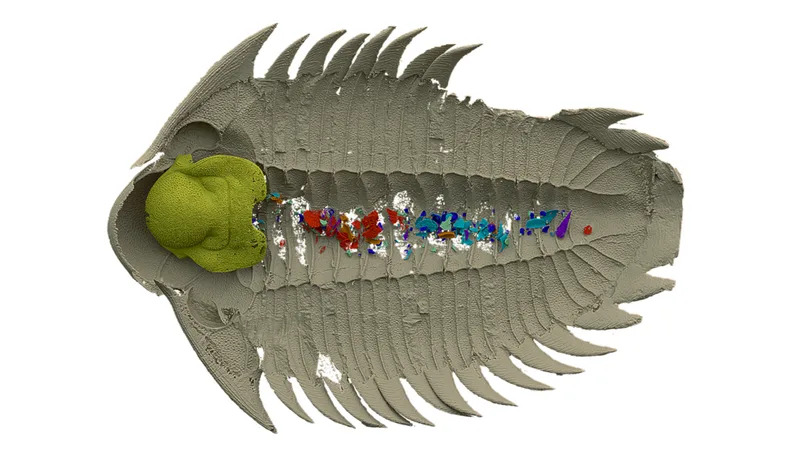Paleontologists Find Trilobite’s Last Meal in 465-Million-Year-Old Fossilized Stomach
Isaac Schultz
Wed, September 27, 2023

Here’s something to chew on: a fossilized trilobite from the Ordovician Period, which is so well preserved that a team of paleontologists was able to identify its last meal, now mineralized in the creature’s fossil stomach.
The discovery is the first direct evidence of the trilobite diet, taken straight from the animal’s belly. Using synchrotron microtomography, the team identified fragmented shells in the trilobite that they attributed to a host of marine critters, including ostracods, hyoliths, and bivalves. The team’s research describing the contents was published today in Nature.
The fossil is of Bohemolichas incola, one of more than 20,000 trilobite species that existed during their 270-million-year reign on Earth. The specimen was found over a century ago—perhaps 1908—and has since been kept at the Museum of Buroslav Horák, in Rokycany, a town in the Czech Republic. Petr Kraft, a paleontologist at Charles University in Prague and the study’s lead author, took note of the fossil and the apparent gut contents when he visited the museum as a child. But the technology to peer within the trilobite didn’t exist.
Now it does, and when Kraft’s former PhD student Valéria Vaškaninová and Ahlberg were working on fossil fishes from the region using synchrotron microtomography, they got in touch with Kraft.
“It was clearly an unselective feeder, basically gobbling up whatever it encountered that was small enough to fit in its mouth, or fragile enough to be broken up with ease,” Ahlberg said. “We can’t really be sure whether the food items were alive, or dead, or a mix of the two.”
The researchers believe the trilobite owes its immaculate preservation to being engulfed and buried by an underwater mud flow. That would make the case of the trilobite surprisingly similar to a remarkable fossil of a mammal and a beaked dinosaur entwined with one another, which was described in a paper published in Scientific Reports in July.
In a gnarly twist, the fossil also showed evidence of burrowing by other scavengers; that is, after the trilobite died, it was itself scavenged by other bottom feeders. Those scavengers tried to get at the trilobite’s soft tissue, the team noted, but avoided the animal’s gut. That may be because the trilobite’s digestive tract had some sort of noxious conditions that made it a less-than-appetizing meal for other Ordovician eaters.
The fossil is a remarkable window into life as a trilobite, and a rare example of how well-preserved remains can reveal about the ancient past.
Gizmodo

Here’s something to chew on: a fossilized trilobite from the Ordovician Period, which is so well preserved that a team of paleontologists was able to identify its last meal, now mineralized in the creature’s fossil stomach.
The discovery is the first direct evidence of the trilobite diet, taken straight from the animal’s belly. Using synchrotron microtomography, the team identified fragmented shells in the trilobite that they attributed to a host of marine critters, including ostracods, hyoliths, and bivalves. The team’s research describing the contents was published today in Nature.
The fossil is of Bohemolichas incola, one of more than 20,000 trilobite species that existed during their 270-million-year reign on Earth. The specimen was found over a century ago—perhaps 1908—and has since been kept at the Museum of Buroslav Horák, in Rokycany, a town in the Czech Republic. Petr Kraft, a paleontologist at Charles University in Prague and the study’s lead author, took note of the fossil and the apparent gut contents when he visited the museum as a child. But the technology to peer within the trilobite didn’t exist.
Now it does, and when Kraft’s former PhD student Valéria Vaškaninová and Ahlberg were working on fossil fishes from the region using synchrotron microtomography, they got in touch with Kraft.
“It was clearly an unselective feeder, basically gobbling up whatever it encountered that was small enough to fit in its mouth, or fragile enough to be broken up with ease,” Ahlberg said. “We can’t really be sure whether the food items were alive, or dead, or a mix of the two.”
The researchers believe the trilobite owes its immaculate preservation to being engulfed and buried by an underwater mud flow. That would make the case of the trilobite surprisingly similar to a remarkable fossil of a mammal and a beaked dinosaur entwined with one another, which was described in a paper published in Scientific Reports in July.
In a gnarly twist, the fossil also showed evidence of burrowing by other scavengers; that is, after the trilobite died, it was itself scavenged by other bottom feeders. Those scavengers tried to get at the trilobite’s soft tissue, the team noted, but avoided the animal’s gut. That may be because the trilobite’s digestive tract had some sort of noxious conditions that made it a less-than-appetizing meal for other Ordovician eaters.
The fossil is a remarkable window into life as a trilobite, and a rare example of how well-preserved remains can reveal about the ancient past.
Gizmodo

No comments:
Post a Comment